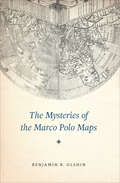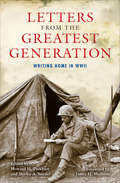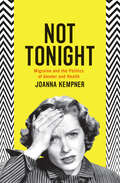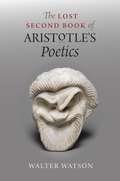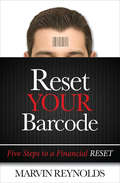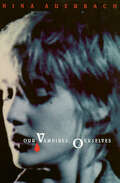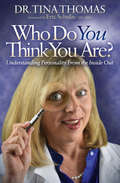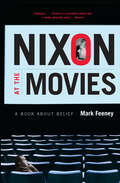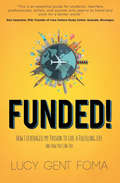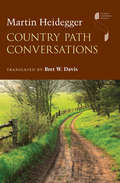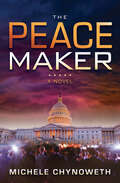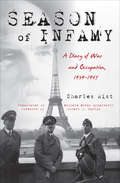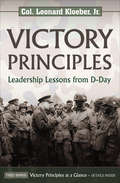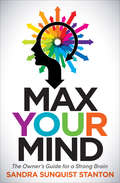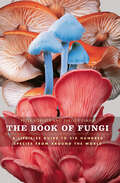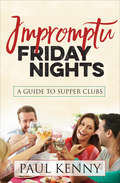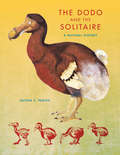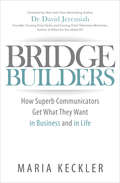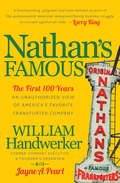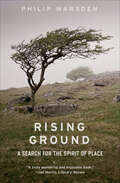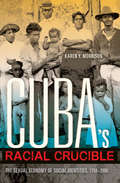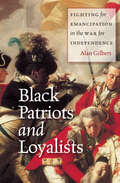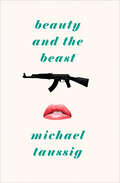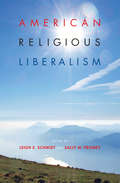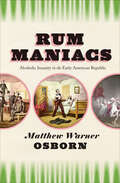- Table View
- List View
The Mysteries of the Marco Polo Maps
by Benjamin B. OlshinWhat&’s the truth behind the travels of Marco Polo? &“A fascinating tale about maps, history and exploration.&”—Times Literary Supplement (UK) In the thirteenth century, Italian merchant and explorer Marco Polo traveled from Venice to the far reaches of Asia, a journey he chronicled in a narrative titled Il Milione, later known as The Travels of Marco Polo. While Polo&’s writings would go on to inspire the likes of Christopher Columbus, scholars have long debated their veracity. Some have argued that Polo never even reached China—while others believe that he came as far as the Americas. Now, there&’s new evidence for this historical puzzle: a very curious collection of fourteen little-known maps and related documents said to have belonged to the family of Marco Polo himself. Here, historian of cartography Benjamin B. Olshin offers the first credible book-length analysis of these artifacts, charting their course from obscure origins in the private collection of Italian-American immigrant Marcian Rossi in the 1930s; to investigations of their authenticity by the Library of Congress, J. Edgar Hoover, and the FBI; to the work of the late cartographic scholar Leo Bagrow; to Olshin&’s own efforts to track down and study the Rossi maps, all but one of which are in the possession of Rossi&’s great-grandson. Are the maps forgeries, facsimiles, or modernized copies? Did Marco Polo&’s daughters—whose names appear on several of the artifacts—preserve in them geographic information about Asia first recorded by their father? Or did they inherit maps created by him? Did Marco Polo entrust the maps to an admiral with links to Rossi&’s family line? Or, if the maps have no connection to Marco Polo, who made them, when, and why? Regardless of the maps&’ provenance, this tale takes us on a fascinating journey, offering insights into Italian history, the age of exploration, and the wonders of cartography. &“Olshin&’s book tugs powerfully at the imagination of anybody interested in the Polo story, medieval history, old maps, geographical ideas, European voyages of discovery, and early Chinese legends.&”—The Wall Street Journal
Letters from the Greatest Generation: Writing Home in WWII
by Howard H. Peckham & Shirley A. SnyderA collection of personal letters from overseas that reveal in day-to-day detail what it was like to serve in World War II. Recounting victory and defeat, love and loss, this is a remarkable and frank collection of World War II letters penned by American men and women serving overseas. Here, the hopes and dreams of the greatest generation fill each page, and their voices ring loud and clear. &“It&’s all part of the game but it&’s bloody and rough,&” writes one soldier to his wife. &“Wearing two stripes now and as proud as an old cat with five kittens,&” remarks another. Yet, as many countries rejoiced on V-E Day, this book reveals that soldiers were &“too tired and sad to celebrate.&” Filled with the everyday thoughts of these fighters, the letters are by turns heartbreaking and amusing, revealing and frightening. While visiting a German concentration camp, one man wrote, &“I don&’t like Army life but I&’m glad we are here to stop these atrocities.&” Meanwhile, in another letter a soldier quips, &“I know lice don&’t crawl so I figured they were fleas.&” A fitting tribute to all veterans, this book brings the experience of war—its dramatic horrors, its dreary hardships, its desperate hope for a better future—to vivid life. &“An intimate portrait of the mundane and remarkable, of heroism and terror, of friendship and loss . . . Timely, compelling, and important reading.&”—Matthew L. Basso, author of Men at Work
Not Tonight: Migraine and the Politics of Gender and Health
by Joanna Kempner&“[An] insightful and eloquent account of our evolving understandings of migraine, from a condition of weak-nerved women, to a &‘real&’…disease&” (Elizabeth Mitchell Armstrong Princeton University). Pain. Vomiting. Hours and days spent lying in the dark. Migraine is an extraordinarily common, disabling, and painful disorder that affects over 36 million Americans and costs the US economy at least $32 billion per year. Nevertheless, it is a frequently dismissed, ignored, and delegitimized condition. In Not Tonight, sociologist Joanna Kempner argues that this general dismissal of migraine can be traced back to the gendered social values embedded in the way we talk about, understand, and care for people in pain. The symptoms that accompany headache disorders—like head pain, visual auras, and sensitivity to sound—lack objective markers of distress that can confirm their existence. Therefore, doctors must rely on the perceived moral character of their patients to gauge how serious their complaints are. Kempner shows how this subjective dimension of diagnosis has shaped the history of migraine. In the nineteenth-century, migraine was seen as a disorder of upper-class intellectual men and hysterical women. In the 1940s, the concept of &“migraine personality&” developed, in which women with migraine were described as uptight neurotics who withheld sex. Even today, we see depictions of people with highly sensitive &“migraine brains.&” Not Tonight casts new light on how cultural beliefs about gender, pain, and the distinction between mind and body influence not only whose suffering we legitimate, but which remedies are marketed, how medicine is practiced, and how knowledge about disease is produced.
The Lost Second Book of Aristotle's Poetics
by Walter WatsonAristotle&’s lost wisdom on comedy and catharsis come to life in this philosopher&’s interpretation of recovered ancient writings.Aristotle&’s Poetics was the first philosophical treatise to propound a theory of literature. But we know that what remains of this important text is incomplete. In the existing material, Aristotle tells us that he will speak of comedy, address catharsis, and give an analysis of what is funny—but these promised chapters are missing. Now, philosopher Walter Watson offers a new interpretation of the lost second book of Aristotle&’s Poetics. A document known as the Tractatus Coislinianus, first recovered in the Biblioteque Nationale in Paris in 1839, appears to be a summary of Aristotle&’s second book. Based on Richard Janko&’s philological reconstruction, Watson mounts a compelling philosophical argument that gives revealing context to this document and demonstrates its hidden meanings. Watson renders lucid and complete explanations of Aristotle&’s ideas about catharsis, comedy, and a summary account of the different types of poetry, ideas that influenced not only Cicero&’s theory of the ridiculous, but also Freud&’s theory of jokes, humor, and the comic. Here, at last, Aristotle&’s lost second book is found again.
Reset Your Barcode: Five Steps to a Financial Reset
by Marvin ReynoldsA new way to think about money that can transform your life and turn struggle into success. Wealth cannot be created or destroyed. It already exists.You cannot spend your way to prosperity.Money doesn&’t buy happiness. It buys options. These are just a few of the financial principles explored in this wise, mind-opening guide to understanding money and its role in our lives—and how we can find our way to financial freedom. In order to have a strong global and national economy, we must strengthen the economy of each and every family. Reset Your Barcode exposes the myths and misconceptions that surround money in the modern world, and introduces time-tested strategies and unique, easy-to-use tools to help you make daily decisions that reduce your financial stress—and bring lasting value to your life.
Our Vampires, Ourselves
by Nina AuerbachThis &“vigorous, witty look at the undead as cultural icons in 19th- and 20th-century England and America&” examines the many meanings of the vampire myth (Kirkus Reviews). From Byron&’s Lord Ruthven to Anne Rice&’s Lestat to the black bisexual heroine of Jewelle Gomez&’s The Gilda Stories, vampires have taken many forms, capturing and recapturing our imaginations for centuries. In Our Vampires, Ourselves, Nina Auerbach explores the rich history of this literary and cultural phenomenon to illuminate how every age embraces the vampire it needs—and gets the vampire it deserves. Working with a wide range of texts, as well as movies and television, Auerbach follows the evolution of the vampire from 19th century England to 20th century America. Using the mercurial figure as a lens for viewing the last two hundred years of Anglo-American cultural history, &“this seductive work offers profound insights into many of the urgent concerns of our time&” (Wendy Doniger, The Nation).
Who Do You Think You Are?: Understanding Personality From the Inside Out
by Tina Thomas&“Step aside Dr. Phil; move over Dr. Oz. I truly believe that Dr. Tina Thomas is to personality psychology what Einstein was to physics . . .&” (Eric Schulze, MD, PhD, researcher, CEO Lifetrack Medical Systems). As Dr. Thomas explains, &“There is no such thing as a difficult person, just people with difficult personalities!&” Those who understand personality and its biological basis never look at themselves or others in the same way again. Understanding personality this way will help you to understand what motivates you and others. This will also improve your ability to communicate. Who Do You Think You Are? will teach you how to adjust your internal and external environments to optimize your specific personality chemistry to become the person you always hoped you could be and create the life circumstances you only dreamed were possible. And, if that isn&’t extraordinary enough, this new knowledge will create more compassion within yourself and more peace within all the relationships you ever had, have now, or will have in the future. Understanding yourself from the inside out may be the single most important body of information you ever need to reach your full potential. Who do you think you are? You may be delighted and surprised when you discover yourself this way! &“Dr. T has an uncanny ability to combine the art of psychology and the science of biology to create elegant ways to increase self-compassion, improve relationships and help people to become self-actualized.&” —Richard Tscherne, PhsD, clinical psychologist, director of The Gestalt Institute and Relationship Center of New York
Nixon at the Movies: A Book about Belief
by Mark Feeney&“People will be arguing over Nixon at the Movies as much as, for more than half a century, the country at large has been arguing about Nixon.&”—Greil Marcus Richard Nixon and the film industry arrived in Southern California in the same year, 1913, and they shared a long and complex history. The president screened Patton multiple times before and during the invasion of Cambodia, for example. In this unique blend of political biography, cultural history, and film criticism, Mark Feeney recounts in detail Nixon&’s enthusiastic viewing habits during his presidency, and takes a new and often revelatory approach to Nixon&’s career and Hollywood&’s, seeing aspects of Nixon&’s character, and the nation&’s, refracted and reimagined in film. Nixon at the Movies is a &“virtuosic&” examination of a man, a culture, and a country in a time of tumult (Slate). &“By Feeney's count, Nixon, an unabashed film buff, watched more than 500 movies during the 67 months of his presidency, all carefully listed in an appendix titled &‘What the President Saw and When He Saw It.&’ Nixon concentrated intently on whatever was on the screen; he refused to leave even if the picture was a dud and everyone around him was restless. He was omnivorous, would watch anything, though he did have his preferences…Only rarely did he watch R-rated or foreign films. He liked happy endings. Movies were obviously a means of escape for him, and as the Watergate noose tightened, he spent ever more time in the screening room.&”—The New York Times
Funded!: How I Leveraged My Passion to Live A Fulfilling Life and How You Can Too
by Lucy Gent Foma&“An essential guide for students, teachers, professionals, artists, and anyone who yearns to travel and work for a better world&” (Ken Carpenter, PhD). You don&’t have to be an extraordinary student to get fellowships and pursue your passions. All it takes is strategic planning and a fellowship-writing skillset. Funded! tells the story of how an average student went on to win a Fulbright among other scholarships, fellowships, and grants to travel the world and pay for her Ivy League education. As a step-by-step guide taking you from the phase of dreaming about your project all the way to finding the right fellowship and preparing your application, Funded! makes the process manageable by breaking it into steps that anyone can follow. If you are looking for an inspiring career or want to activate a dormant passion in your work, Funded! will teach you the foundational skills to become the change agent you want to be. And for those who want to take time off from their regular job or switch careers, adding a grant, scholarship, or fellowship to their resume can help. Funded! tells you how to become the competitive applicant that these scholarship committees look for—including tips from actual Fulbright reviewers.
Country Path Conversations (Studies in Continental Thought)
by Martin HeideggerThe philosopher&’s meditations on nature, technology, and evil, written in the final years of WWII, presented in &“clear and highly readable translation&” (Philosophy in Review). First published in German in 1995, volume 77 of Heidegger&’s Complete Works consists of three imaginary conversations written as World War II was coming to an end. Composed at a crucial moment in history and in Heidegger&’s own thinking, these conversations present meditations on science and technology; the devastation of nature, World War II, and the nature of evil. Heidegger also delves into the possibility of release from representational thinking into a more authentic relation with being and the world. The first conversation involves a scientist, a scholar, and a guide walking together on a country path; the second takes place between a teacher and a tower-warden, and the third features a younger man and an older man in a prisoner-of-war camp in Russia, where Heidegger&’s two sons were missing in action. Unique because of their conversational style, this lucid and precise translation of these texts offers insight into the issues that engaged Heidegger&’s wartime and postwar thinking.
The Peace Maker: A Novel
by Michele ChynowethThe Bible story of Abigail and David reimagined as a twenty-first century novel of ruthless political ambition and devastating family secrets. A provocative and timely thriller in which the fate of the world depends on a single election. Leif Mitchell has gone from a humble life as a stable hand and country rock singer to become Governor of Kentucky. Now he&’s running as the Republican candidate for the Presidency. The contender: US democratic Senator Darren Richards. But its Richards&’ wife Chessa who is privy to not only her husband&’s damaging secrets, but also a vengeful plan of attack by Mitchell to bring down his opponent by any means necessary. As the increasingly vicious campaign escalates, the &“high road&” to victory is all but destroyed. Now it&’s up to Chessa to try and preserve peace on both sides. But more than the futures of Richards and Mitchell are in question. The likely First Lady is putting herself the middle of a political crossfire in which her own life could be at risk.
Season of Infamy: A Diary of War and Occupation, 1939-1945
by Charles Rist&“A valuable account of what one significant and perceptive Frenchman experienced during the protracted disgrace of France as a vassal state of Nazi Germany.&” —Publishers Weekly In 1939, the 65-year-old French political economist Charles Rist was serving as advisor to the French government and consultant to the international banking and business world. As France anxiously awaited a German invasion, Rist traveled to America to negotiate embargo policy. Days after his return to Paris, the German offensive began and with it the infamous season of occupation. Retreating to his villa in Versailles, Rist turned his energies to the welfare of those closest to him, while in his diary he began to observe the unfolding of the war. Here the deeply learned Rist investigates the causes of the disaster and reflects on his country&’s fate, placing the behavior of the &“people&” and the &“elite&” in historical perspective. Though well-connected, Rist and his family and friends were not exempt from the perils and tragedies of war, as the diary makes clear. Season of Infamy presents a distinctive, closely-observed view of life in France under the occupation.
Victory Principles: Leadership Lessons from D-Day
by Col. Leonard Kloeber Jr.From a longtime leader in both military and business organizations, lessons inspired by World War II history that anyone can use. This practical book explores seven essential leadership principles that all successful leaders use, drawing from the compelling story of the Allied invasion of Normandy. Learn how you can put these same principles to work today as a leader in your own organization, your community, or your personal life. VisionInnovation and LearningCapability: People and ResourcesTimely Decisions: AIME Decision ModelOperating Principles and ValuesResilienceYour Team and Team Building
Max Your Mind: The Owner's Guide for a Strong Brain
by Sandra Sunquist StantonAn inspiring guide to keeping your mind, body, and spirit working together to keep you sharp, healthy, and happy through life. Frustrated with your brain? How would you like to remember where you put your car keys? Is multitasking working for you? Do you ever wonder how you drove to your destination? If the answer is yes, you may be painfully aware of &“the Fade&”—the decline in mental, physical and spiritual wellness so many of us experience in our later years. But contrary to what you may have heard, it doesn&’t have to be that way. Max Your Mind introduces you to &“the Boost&”—or the many benefits that come with maturity. With plenty of tips on how to stay sharp, this helpful guide offers a refreshingly lighthearted and spiritual perspective on this typically serious subject. Using anecdotal stories to illustrate the latest neuroscience research, Max Your Mind is full of practical information that we can apply to our everyday lives. So if you want to give your mind the wake-up call that God intended, open this book and enjoy the hope, help and humor within its pages.
The Book of Fungi: A Life-Size Guide to Six Hundred Species from around the World
by Shelley Evans Peter Roberts&“The lurid photographs and enticing, offhandedly witty descriptions make the reader want to go out collecting specimens right away."—Popular Science From morels to chanterelles, toadstools to truffles, fungi have been a source of fascination since the earliest hunter-gatherers first foraged for them. Today there are few, if any, places on Earth where fungi have not found themselves a home—their habitats span the poles and the tropics, mountaintops and backyards. Packed with facts and photos, this book introduces you to fungus in many forms—some parasitic, some poisonous, some hallucinogenic and some with healing properties that can be tapped for pharmaceutical products. Then of course, there are the delicious mushrooms that are prized by epicureans and gourmands worldwide. Each species here is reproduced at its actual size, in full color, and accompanied by a scientific explanation of its distribution, habitat, association, abundance, growth form, spore color, and edibility. With information on the characteristics, locations, distinguishing features, and occasionally bizarre habits of these fungi, you&’ll find in this book the common and the conspicuous, the unfamiliar and the odd—including a fungal predator, for instance, that hunts its prey with lassos, and several that set traps, including one that entices sows by releasing the pheromones of a wild boar. &“How dazzling is the world of mushrooms? The fan-shaped cinnabar oysterling looks like something you would find undersea. The violet webcap is vibrant. These are among the more than 600 fungi described and illustrated in this scholarly and beautiful book.&”—TheNew York Times &“Anyone with an appreciation of the beauty of nature will enjoy.&”—Grand Forks Herald
Impromptu Friday Nights: A Guide to Supper Clubs
by Paul KennyThe ultimate guide to hosting dinner parties of every size, from choosing guests to choosing themes—includes recipes and menu plans. Almost everyone likes to socialize over a meal. Supper clubs that bring people together to enjoy a meal are natural enablers. The concept of supper clubs (hosting regular dinner parties) seems simple, but the &“how to&” can be daunting. Impromptu Friday Nights shows the reader how to set up supper clubs, provides options for different club formats, from large and formal to small and informal, and includes sample menus with recipes. Author Paul J. Kenny and his wife have been in many different types of supper clubs for most of their adult lives. They have been in large, formal clubs, small, informal ones and several others in between. Through these experiences, Paul has learned what works for a group and what doesn&’t. As part of these clubs, he has been writing menus and recipes for years. He is a foodie and comes from a long line of foodies who love to entertain. &“Paul Kenny&’s Impromptu Friday Nights directs the reader to focus on the most important building blocks of successful culinary entertainment . . . In an era of over-promising, misleading complexity, and verbosity this book simplifies the task, empowers the host to shine, and grants him/her success every time.&” —Lucien Vendôme, former director of culinary innovation for Nestle
The Dodo and the Solitaire: A Natural History (Life of the Past)
by Jolyon C. ParishThis account of two extinct bird species offers &“an amazing amount of history, references, facts, maps, and illustrations&” (Library Journal). The Dodo and the Solitaire is the most comprehensive book to date about these two famously extinct birds. It contains all the known contemporary accounts and illustrations of the dodo and solitaire, covering their history after extinction and discussing their ecology, classification, phylogenetic placement, and evolution. Both birds were large and flightless and lived on inhabited islands some five hundred miles east of Madagascar. The first recorded descriptions of the dodo were provided by Dutch sailors who encountered them in 1598—and within a century, the dodo was extinct. So quickly did the bird disappear that there is insufficient evidence to form an entirely accurate picture of its appearance and ecology, and the absence has led to much speculation. This extraordinary book pieces together the story of these two lost species from the fragments that have been left behind. &“An up-to-date and comprehensive review of everything we know about the dodo and solitaire.&” —Journal of Verterbrate Paleontology
Bridge Builders: How Superb Communicators Get What They Want in Business and in Life
by Maria KecklerA powerful fable that delivers a simple but highly effective blueprint for communication success in business and beyond. How we choose to communicate determines the difference between success and failure—in all of our endeavors. Bridge Builders is a compelling fable of self-discovery about Daniel Reed&’s journey from ordinary communicator to inspirational Bridge Builder. It&’s about the power of crafting messages through the eyes of our audience. It&’s about learning to craft our message differently as others&’ needs become the impetus behind our message. No matter who you are or what you do, incorporating key Bridge Builder principles and best practices will revitalize your vision for the way you connect with people. Bridge Builders gives you the strategic tools you need to connect to the hearts and minds of your audiences and achieve the objectives that are important to you.
Nathan's Famous: An Unauthorized View of America's Favorite Frankfurter Company
by Jayne A. Pearl William Handwerker&“A heartwarming, poignant and even-handed account of the quintessential American immigrant/family business struggle to succeed against all odds&” (Larry King). Nathan&’s Famous chronicles the history and business strategies of company founder Nathan Handwerker that led to the success of an iconic international brand and two of America&’s most loved foods: the Nathan&’s Famous Frankfurter and Crinkle-cut French Fries. Brimming with photos of historic Coney Island, New York, Nathan&’s Famous restaurants, and intimate family memories of author, former company Senior Vice president and grandson William Handwerker, Nathan&’s Famous details entrepreneurial spirit, business lessons, dramatic corporate missteps and growth. William includes insights into three generations of the Handwerker family, beginning with the founder&’s early life, growing up in extreme poverty in Galicia, Poland, as well as his own sons and grandson who contributed to expanding geographic locations, menu and the overall brand. Nathan&’s may have started as a small hot dog stand in 1916, but by sticking to his philosophy to &“give &’em and let &’em eat,&” he was able to beat his competition by providing top quality food at low prices. Nathan&’s Famous reveals the successes, trials and tribulations of growing Nathan&’s original vision into the international frankfurter corporation it is today.
Rising Ground: A Search for the Spirit of Place
by Philip MarsdenThe travel writer and Cornwall native explores his home on a journey by foot to Land&’s End in this &“fascinating and hauntingly evocative&” memoir (Literary Review). A Guardian, Financial Times, Observer, and Scotsman Book of the Year In 2010, Philip Marsden moved with his family to a rundown farmhouse in Cornwall, England. From the moment he arrived, Marsden was fascinated by the landscape and the traces of human history all around him. Wanting to experience the place more fully, he set out to walk across Cornwall, to the evocatively named Land&’s End. Rising Ground is a record of that journey, but it is also so much more: a beautifully written meditation on place, nature, and human life that encompasses history, archaeology, geography, and the love of place that suffuses us when we finally find home. Firmly in a storied tradition of English nature writing that stretches from Gilbert White to Helen MacDonald, Rising Ground reveals the ways that places and peoples have interacted over time, from standing stones to footpaths, ancient habitations to modern highways. What does it mean to truly live in a place, and what does it take to understand, and honor, those who lived and died there long before we arrived? "A fascinating study of place and its meaning."—Observer, UK
Cuba's Racial Crucible: The Sexual Economy of Social Identities, 1750–2000 (Blacks in the Diaspora)
by Karen Y. MorrisonThis prize-winning study examines the historical interplay of racial identity, nationality, and family formation in Cuba from the 18th century to today.Since the 19th century, there have been two opposing perspectives on Cuban racial identity: one that frames Cubans as white, and one that sees them as racially mixed based on acceptance of African descent. For the past two centuries, these competing views of have remained in continuous tension, while Cuban women and men make their own racially oriented decisions about choosing partners and family formation.Cuba&’s Racial Crucible explores the historical dynamics of Cuban race relations by highlighting the role race has played in reproductive practices and genealogical memories associated with family formation. Karen Y. Morrison reads archival, oral-history, and literary sources to demonstrate the ideological centrality and inseparability of "race," "nation," and "family," in definitions of Cuban identity. Morrison also analyzes the conditions that supported the social advance and decline of notions of white racial superiority, nationalist projections of racial hybridity, and pride in African descent.Winner, NECLAS Marissa Navarro Best Book Prize
Black Patriots and Loyalists: Fighting for Emancipation in the War for Independence
by Alan GilbertA surprising look at the roles of African Americans in the Revolutionary War: &“An elegant and passionate writer, Alan Gilbert pulls no punches.&”—Historian We think of the American Revolution as the war for independence from British colonial rule. But, of course, that independence actually applied to only a portion of the American population—African Americans would still be bound in slavery for nearly another century. Drawing on first-person accounts and primary sources, Alan Gilbert asks us to rethink what we know about the Revolutionary War, to realize that while white Americans were fighting for their freedom, many black Americans were joining the British imperial forces to gain theirs. Further, a movement led by sailors—both black and white—pushed strongly for emancipation on the American side. There were actually two wars being waged at once: a political revolution for independence from Britain, and a social revolution for emancipation and equality—planting the seeds for future freedom. &“The personal stories of those who fought on the patriots&’ side in an all-black regiment and on the loyalist side in exchange for a promise of freedom are fascinating and informative.&”—Booklist
Beauty and the Beast
by Michael TaussigThe celebrated anthropologist and author of The Corn Wolf examines the Colombian culture of plastic surgery and its surprising relationship to violence. Drawing on extensive fieldwork in Colombia, Michael Taussig scrutinizes the audacious and sometimes destructive attempts people make to transform their bodies through cosmetic surgery and liposuction. He balances an examination of surgeries meant to enhance an individual&’s beauty with their often-overlooked counterparts, surgeries performed—often on high profile criminals—to disguise one&’s identity. Exploring this global phenomenon through Colombia&’s economic, cultural, and political history, Taussig links the country&’s long civil war and history of torture to the beauty industry at large, sketching Colombia as a country whose high aesthetic stakes make it a staging ground for some of the most important and problematic ideas about the body. Central to Taussig&’s examination is George Bataille&’s notion of depense, or &“wasting.&” While depense is often used as a critique, Taussig also looks at its position as a driving economic force. Depense, he argues, is precisely what these procedures are about, and the beast on the other side of beauty should not be dismissed as simple recompense. At once theoretical and colloquial, public and intimate, Beauty and the Beast is a true-to-place ethnography that tells a layered story about the lengths to which people will go to be physically remade.
American Religious Liberalism (Religion in North America)
by Leigh E. Schmidt and Sally M. PromeyAn enlightening look at the surprising connections between spirituality and progressive thought in the United States. Religious liberalism in America is often associated with an ecumenical Protestant establishment. This book, however, draws attention to the broad diversity of liberal cultures that shapes America&’s religious movements. The essays gathered here push beyond familiar tropes and boundaries to interrogate religious liberalism&’s dense cultural leanings by looking at spirituality in the arts, the politics and piety of religious cosmopolitanism, and the interaction between liberal religion and liberal secularism. Readers will find a kaleidoscopic view of many of the progressive strands of America&’s religious past and present in this richly provocative volume.
Rum Maniacs: Alcoholic Insanity in the Early American Republic
by Matthew Warner Osborn"This important study explores the medicalization of alcohol abuse in the 19th century US&” and its influence on American literature and popular culture (Choice). In Rum Maniacs, Matthew Warner Osborn examines the rise of pathological drinking as a subject of medical interest, social controversy, and lurid fascination in 19th century America. At the heart of that story is the disease that afflicted Edgar Allen Poe: delirium tremens. Poe&’s alcohol addiction was so severe that it gave him hallucinations, such as his vivid recollection of standing in a prison cell, fearing for his life, as he watched men mutilate his mother&’s body—an event that never happened. First described in 1813, delirium tremens and its characteristic hallucinations inspired sweeping changes in how the medical profession saw and treated the problems of alcohol abuse. Based on new theories of pathological anatomy, human physiology, and mental illness, the new diagnosis established the popular belief that habitual drinking could become a psychological and physiological disease. By midcentury, delirium tremens had inspired a wide range of popular theater, poetry, fiction, and illustration. This romantic fascination endured into the twentieth century, most notably in the classic Disney cartoon Dumbo, in which a pink pachyderm marching band haunts a drunken young elephant. Rum Maniacs reveals just how delirium tremens shaped the modern experience of alcohol addiction as a psychic struggle with inner demons.
